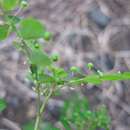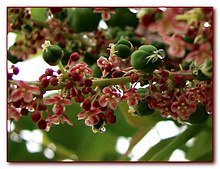en
names in breadcrumbs







Phyllanthus is the largest genus in the plant family Phyllanthaceae. Estimates of the number of species in this genus vary widely, from 750[2] to 1200.[3] Phyllanthus has a remarkable diversity of growth forms including annual and perennial herbs, shrubs, climbers, floating aquatics, and pachycaulous succulents. Some have flattened leaflike stems called cladodes. It has a wide variety of floral morphologies and chromosome numbers and has one of the widest range of pollen types of any seed plant genus.
Despite their variety, almost all Phyllanthus species express a specific type of growth called "phyllanthoid branching" in which the vertical stems bear deciduous, floriferous (flower-bearing), plagiotropic (horizontal or oblique) stems. The leaves on the main (vertical) axes are reduced to scales called "cataphylls", while leaves on the other axes develop normally.[4] Phyllanthus is distributed in all tropical and subtropical regions on Earth.
Phyllanthus was first described by Carl Linnaeus in 1753,[5][6] but the type was not designated.[5]
The circumscription of this genus has been a cause of much confusion and disagreement. Molecular phylogenetic studies have shown that Phyllanthus is paraphyletic over Reverchonia, Glochidion, Sauropus, and Breynia. A recent revision of the family Phyllanthaceae has subsumed all four of these genera into Phyllanthus.[7] This enlarged version of Phyllanthus might eventually be divided into smaller genera,[8][9] including 32 Chinese (and northern Indochinese) species.[10] A complete overhaul of the genus, including a new classification is currently underway, following a recent indepth molecular treatment of major groups included. [11]
Selected species:
Two fossil seeds of a Phyllanthus species have been extracted from borehole samples of the Middle Miocene fresh water deposits in Nowy Sacz Basin, West Carpathians, Poland. The seeds are similar to seeds of the fossil species †Phyllanthus triquetra and †Phyllanthus compassica from the Oligocene and Miocene of West Siberia. Phyllanthus fossils are known from several Miocene and Pliocene sites in Poland.[15]
Phyllanthus are of note in the fields of pollination biology and coevolution because some but not all species in the genus have a specialized mutualism with moths in the genus Epicephala (leafflower moths), in which the moths actively pollinate the flowers. While ensuring that the tree may produce viable seeds, the moths also lay eggs in the flowers' ovaries where their larvae consume a subset of the developing seeds as nourishment.[16][17] Other species of Epicephala are pollinators of certain species of plants in the genera Glochidion[18][19] and Breynia,[20][21] both of which are phylogenetically nested within Phyllanthus.[22]
Particularly for its content of tannins, P. emblica fruit has a history of use in traditional medicine and is under study for its potential biological properties.[23] Leaves, roots, stem, bark and berries of this genus contain lignans and other phytochemicals.[24][25][26]
 Plagiotropic shoots of Phyllanthus pulcher
Plagiotropic shoots of Phyllanthus pulcher  Fruit of Phyllanthus acidus
Fruit of Phyllanthus acidus  Male and female flowers of Phyllanthus acidus
Male and female flowers of Phyllanthus acidus  Flattened stems and flowers of Phyllanthus angustifolius
Flattened stems and flowers of Phyllanthus angustifolius  Green and purplish crimson tinted leaves of Phyllanthus urinaria
Green and purplish crimson tinted leaves of Phyllanthus urinaria Phyllanthus is the largest genus in the plant family Phyllanthaceae. Estimates of the number of species in this genus vary widely, from 750 to 1200. Phyllanthus has a remarkable diversity of growth forms including annual and perennial herbs, shrubs, climbers, floating aquatics, and pachycaulous succulents. Some have flattened leaflike stems called cladodes. It has a wide variety of floral morphologies and chromosome numbers and has one of the widest range of pollen types of any seed plant genus.
Despite their variety, almost all Phyllanthus species express a specific type of growth called "phyllanthoid branching" in which the vertical stems bear deciduous, floriferous (flower-bearing), plagiotropic (horizontal or oblique) stems. The leaves on the main (vertical) axes are reduced to scales called "cataphylls", while leaves on the other axes develop normally. Phyllanthus is distributed in all tropical and subtropical regions on Earth.
Phyllanthus was first described by Carl Linnaeus in 1753, but the type was not designated.